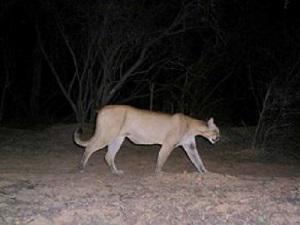Verónica Quiroga
Other projects
15 May 2008
Ecology and Conservation of the Jaguar (Panthera onca) and the Puma (Puma concolor) in the Argentine Semi-Arid Chaco: Influence of Prey Availability and Human Presence in the Region
The general objective is to study the ecology of the jaguar and the puma in the Argentine Chaco, including distribution, density, prey availability and sympatric relations between the two species. Comparing sites with different levels and types of human interference and determining the principal conservation problems facing these species in the region.

Puma concolor, camera trap photo. © Veronica Quiroga.
Research on jaguars and pumas in the Argentine Chaco is extremely limited, and the information vacuum is an important obstacle to conservation efforts. We are studying the ecology of both species, including distribution, density, prey availability and sympatric relations between them determining the principal conservation problems facing these species in the region. We are working within the Chaco Green Corridor of the Impenetrable region: In 2008 we worked in the Aboriginal Reserve were we stayed for near three months and where we worked with 30 camera traps stations covering a minimum convex polygon area of 44,903 has.

One of the 79 Pumas capture by the camera trap in Copo. © Veronica Quiroga.
We also conducted line transect surveys and interviews with local people. In this site human inhabitants are few, but it is vulnerable in terms of access by hunters from ranches and towns and livestock also occasionally enters the reserve, generating conflicts between people and large cats.
In calendar year 2009, we will work at Copo National Park and Reserve. Copo is the only national park within the Semi-arid Chaco region, constitute the best-protected portion of the Argentine Chaco and one of the most promising sites in terms of the survival of the jaguar in the region. One important outcome of the first year of sampling, was the absence of jaguar photographs in the camera traps.
This is indicating that the density of the species at this site is much smaller than we expected. This highlights the urgent need to take action in managing the species in the region much earlier than we expected. The fact that we obtained data on the species, from sightings by the local people as well as tracks that we recorded ourselves, is also an important result because it confirms that the species is still in the region despite the low density.
The lack of jaguar photographs in Aboriginal Reserve was not an unexpected result for this area and perhaps is not a result not expected for Copo, because we know that the species is in serious trouble in the region. But, precisely, the importance of this second survey in Copo and in others areas of the region is based in the need of determine how serious the situation is, in which sites of the Chaco Green Corridor is still the species and hopefully, what is its density in the best-preserved sites.